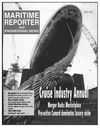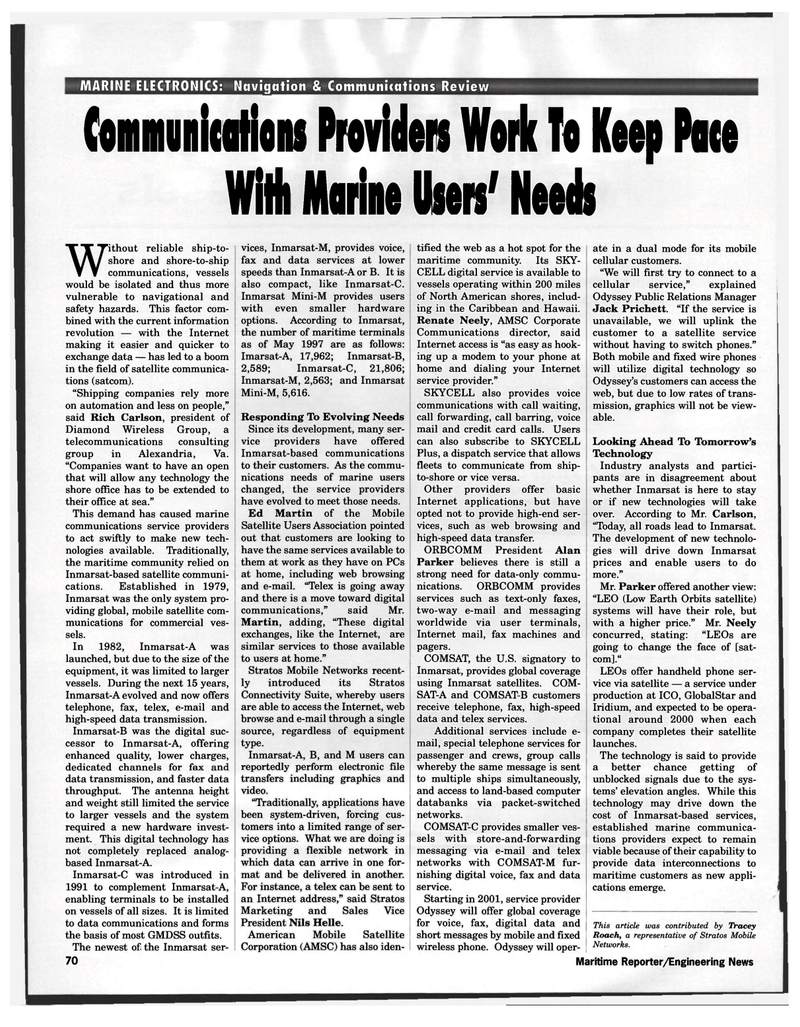
Page 70: of Maritime Reporter Magazine (July 1997)
Read this page in Pdf, Flash or Html5 edition of July 1997 Maritime Reporter Magazine
MARINE ELECTRONICS: Navigation & Communications Review
Communications Providers Woric To Keep Pace
WHh Marine Usen' Needs
Without reliable ship-to-shore and shore-to-ship communications, vessels would be isolated and thus more vulnerable to navigational and safety hazards. This factor com- bined with the current information revolution — with the Internet making it easier and quicker to exchange data — has led to a boom in the field of satellite communica- tions (satcom). "Shipping companies rely more on automation and less on people," said Rich Carlson, president of
Diamond Wireless Group, a telecommunications consulting group in Alexandria, Va. "Companies want to have an open that will allow any technology the shore office has to be extended to their office at sea."
This demand has caused marine communications service providers to act swiftly to make new tech- nologies available. Traditionally, the maritime community relied on
Inmarsat-based satellite communi- cations. Established in 1979,
Inmarsat was the only system pro- viding global, mobile satellite com- munications for commercial ves- sels.
In 1982, Inmarsat-A was launched, but due to the size of the equipment, it was limited to larger vessels. During the next 15 years,
Inmarsat-A evolved and now offers telephone, fax, telex, e-mail and high-speed data transmission.
Inmarsat-B was the digital suc- cessor to Inmarsat-A, offering enhanced quality, lower charges, dedicated channels for fax and data transmission, and faster data throughput. The antenna height and weight still limited the service to larger vessels and the system required a new hardware invest- ment. This digital technology has not completely replaced analog- based Inmarsat-A.
Inmarsat-C was introduced in 1991 to complement Inmarsat-A, enabling terminals to be installed on vessels of all sizes. It is limited to data communications and forms the basis of most GMDSS outfits.
The newest of the Inmarsat ser- 70 vices, Inmarsat-M, provides voice, fax and data services at lower speeds than Inmarsat-A or B. It is also compact, like Inmarsat-C.
Inmarsat Mini-M provides users with even smaller hardware options. According to Inmarsat, the number of maritime terminals as of May 1997 are as follows:
Imarsat-A, 17,962; Inmarsat-B, 2,589; Inmarsat-C, 21,806;
Inmarsat-M, 2,563; and Inmarsat
Mini-M, 5,616.
Responding To Evolving Needs
Since its development, many ser- vice providers have offered
Inmarsat-based communications to their customers. As the commu- nications needs of marine users changed, the service providers have evolved to meet those needs.
Ed Martin of the Mobile
Satellite Users Association pointed out that customers are looking to have the same services available to them at work as they have on PCs at home, including web browsing and e-mail. "Telex is going away and there is a move toward digital communications," said Mr.
Martin, adding, "These digital exchanges, like the Internet, are similar services to those available to users at home."
Stratos Mobile Networks recent- ly introduced its Stratos
Connectivity Suite, whereby users are able to access the Internet, web browse and e-mail through a single source, regardless of equipment type.
Inmarsat-A, B, and M users can reportedly perform electronic file transfers including graphics and video. "Traditionally, applications have been system-driven, forcing cus- tomers into a limited range of ser- vice options. What we are doing is providing a flexible network in which data can arrive in one for- mat and be delivered in another.
For instance, a telex can be sent to an Internet address," said Stratos
Marketing and Sales Vice
President Nils Helle.
American Mobile Satellite
Corporation (AMSC) has also iden- tified the web as a hot spot for the maritime community. Its SKY-
CELL digital service is available to vessels operating within 200 miles of North American shores, includ- ing in the Caribbean and Hawaii.
Renate Neely, AMSC Corporate
Communications director, said
Internet access is "as easy as hook- ing up a modem to your phone at home and dialing your Internet service provider."
SKYCELL also provides voice communications with call waiting, call forwarding, call barring, voice mail and credit card calls. Users can also subscribe to SKYCELL
Plus, a dispatch service that allows fleets to communicate from ship- to-shore or vice versa.
Other providers offer basic
Internet applications, but have opted not to provide high-end ser- vices, such as web browsing and high-speed data transfer.
ORBCOMM President Alan
Parker believes there is still a strong need for data-only commu- nications. ORBCOMM provides services such as text-only faxes, two-way e-mail and messaging worldwide via user terminals,
Internet mail, fax machines and pagers.
COMSAT, the U.S. signatory to
Inmarsat, provides global coverage using Inmarsat satellites. COM-
SAT-A and COMSAT-B customers receive telephone, fax, high-speed data and telex services.
Additional services include e- mail, special telephone services for passenger and crews, group calls whereby the same message is sent to multiple ships simultaneously, and access to land-based computer databanks via packet-switched networks.
COMSAT-C provides smaller ves- sels with store-and-forwarding messaging via e-mail and telex networks with COMSAT-M fur- nishing digital voice, fax and data service.
Starting in 2001, service provider
Odyssey will offer global coverage for voice, fax, digital data and short messages by mobile and fixed wireless phone. Odyssey will oper- ate in a dual mode for its mobile cellular customers. "We will first try to connect to a cellular service," explained
Odyssey Public Relations Manager
Jack Prichett. "If the service is unavailable, we will uplink the customer to a satellite service without having to switch phones."
Both mobile and fixed wire phones will utilize digital technology so
Odyssey's customers can access the web, but due to low rates of trans- mission, graphics will not be view- able.
Looking Ahead To Tomorrow's
Technology
Industry analysts and partici- pants are in disagreement about whether Inmarsat is here to stay or if new technologies will take over. According to Mr. Carlson, "Today, all roads lead to Inmarsat.
The development of new technolo- gies will drive down Inmarsat prices and enable users to do more."
Mr. Parker offered another view: "LEO (Low Earth Orbits satellite) systems will have their role, but with a higher price." Mr. Neely concurred, stating: "LEOs are going to change the face of [sat- com]."
LEOs offer handheld phone ser- vice via satellite — a service under production at ICO, GlobalStar and
Iridium, and expected to be opera- tional around 2000 when each company completes their satellite launches.
The technology is said to provide a better chance getting of unblocked signals due to the sys- tems' elevation angles. While this technology may drive down the cost of Inmarsat-based services, established marine communica- tions providers expect to remain viable because of their capability to provide data interconnections to maritime customers as new appli- cations emerge.
This article was contributed by Tracey
Roach, a representative of Stratos Mobile
Networks.
Maritime Reporter/Engineering News

 69
69

 71
71
